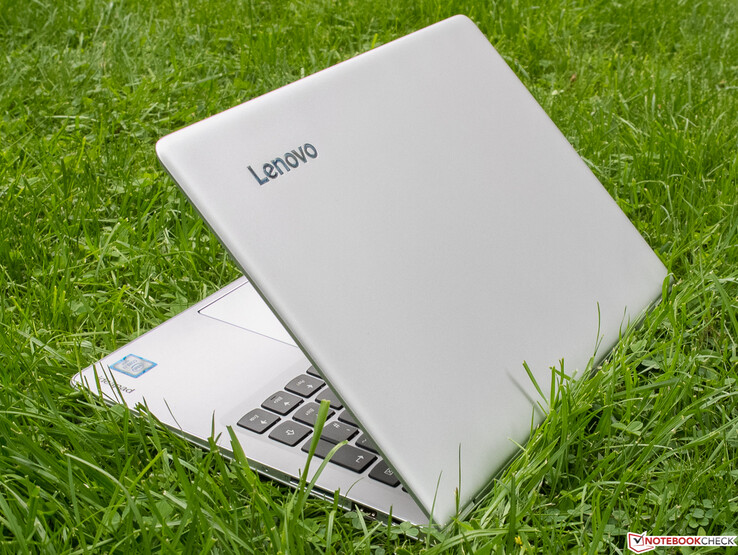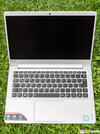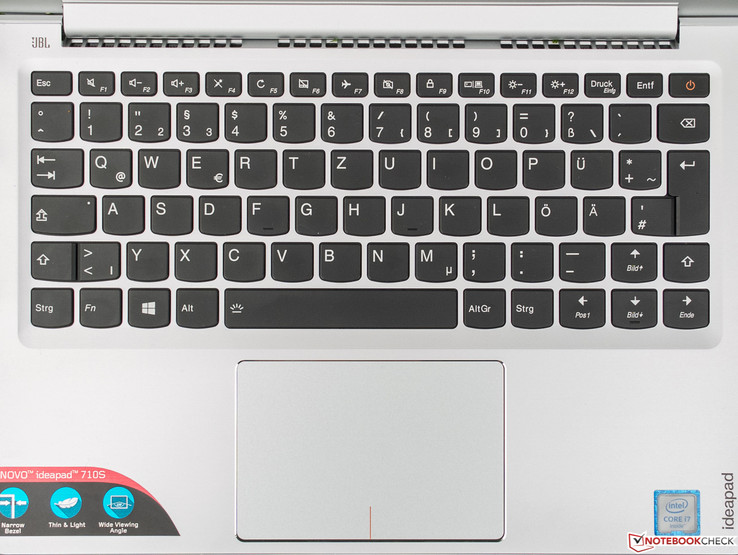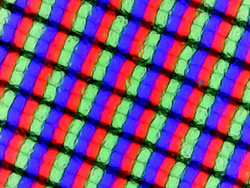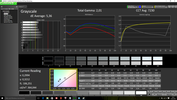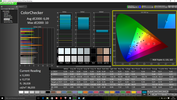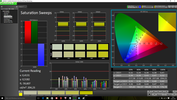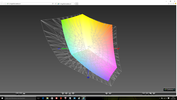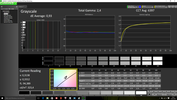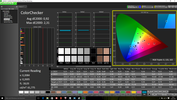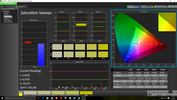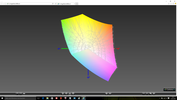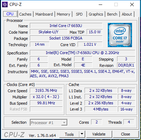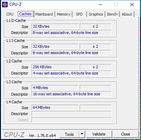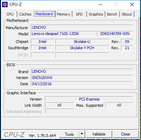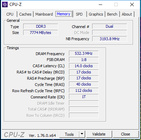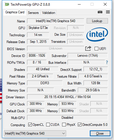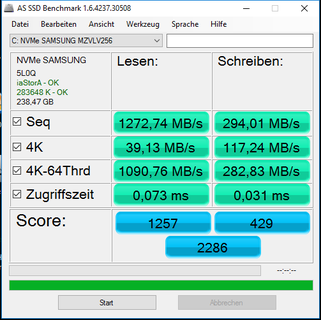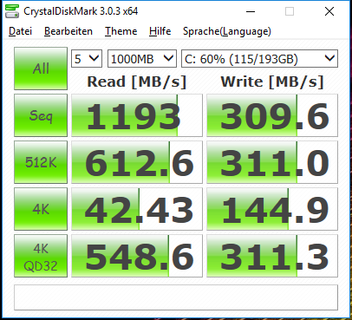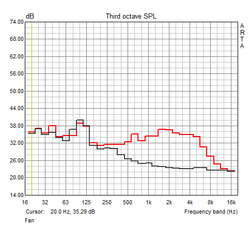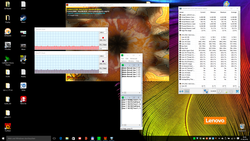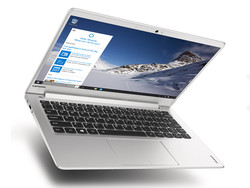Lenovo IdeaPad 710S-13ISK (Core i7) Subnotebook Review

For the original German review, see here.
The new Lenovo IdeaPad 710S-13ISK is a light, thin, and compact 13-inch device. We are a bit surprised that the two models currently available in Germany have the exact same designation and that it is designed to be a very mobile office working device. Inside our 1.2 kg test model with the internal designation 80SW003LGE, which retails for 1,099 Euros (~$1244), is a frugal Hyper-Threading dual-core Intel Core i7-6560U with the integrated graphics Intel Iris 540 and 8 GB RAM. The storage device is an SSD with 256 GB. Lenovo did not save money in terms of the display, either, and it uses a Full HD IPS panel.
The less expensive version 80SW003MGE already retails for 849 Euros (~$961) at the time of writing. The difference is the smaller memory capacity of 4 GB as well as the slightly slower processor i5-6200U.
While looking for some comparison devices for this article, we mainly focused on the size, price, performance and popularity. These are our contenders:
Another word about the availability: At the time of writing, the two models were only available directly from Lenovo as well as Campuspoint, where we also got the prices from. Campuspoint does offer discounts for special user groups like students or teachers.
Case
According to the manufacturer, the lid is made of aluminum and magnesium, while the "bottom" is only made of aluminum. This does help the stability, because you can hardly twist the thin and light base unit and there is almost no creaking at all. Fingerprints are not visible on the silver-matte surfaces, which do shimmer a bit. Lenovo follows the design language of the attractive and simple MacBook Air a bit but waives a complex unibody chassis.
The author liked the 710S so much that it got the maximum number of points in all corresponding rating categories, which is pretty rare. The excellent impression is rounded off by the almost perfect build quality with even gaps and without protruding edges. The hinges of very mobile devices should be able to prevent longer bouncing during sudden movements, which can happen in the car or on a train, for example. Lenovo did a nice job here, but you can only open the thin, yet still very pressure-resistant lid with two hands in return.
Connectivity
Because of the very thin construction, you only get the most necessary connections. This means only 2x USB 3.0 and Mini-HDMI. The fact that an adapter to standard HDMI is not included is unfortunately normal, but they are also pretty inexpensive and easy to get. If you want to transport a lot of files, you will not like the lack of an Ethernet port. You cannot physically secure the notebook since there is no slot for a Kensington lock – this is really rare.
The base unit gets even thinner towards the front, so the limited number of ports are ergonomically well-placed at the rear areas of the sides. If you need more ports, you should have a look at the Dell XPS 13, which even offers a universal Thunderbolt port besides the DisplayPort.
Communication
Wireless network connections with the 710S can be established via the Wi-Fi module Intel Dual Band Wireless-AC 3165, which is not the latest but at least a proven module. The name already suggests that it also supports the less crowded 5 GHz band besides 2.4 GHz. Contrary to the newer and much more popular Intel Dual Band Wireless-AC 8260, it only has one antenna (MIMO 1x1), so the theoretical transfer rate is up to 433 Mbps in an ac-network (5 GHz). The hardware also supports Bluetooth 4.2. We determined average results for the transfer rates at 296 and 224 Mbps (transmit/receive) in combination with our router Linksys EA8500 (short distance, direct sight).
Accessories
Except for the usual setup and warranty information as well as the mandatory power adapter, there are no further accessories in the box. There are no recovery drives, either, but you get a recovery partition instead, which should not be deleted.
Maintenance
The bad news: You cannot even replace the battery without tools. The good news: There is a bottom panel, which seems to be easy to remove. It is secured by nine screws.
Warranty
Lenovo grants a 24-month Bring-In warranty, but the battery is only covered for 12 months. It is possible to extend the service period for an additional charge.
Input Devices
Keyboard
The black keyboard sits in a slight depression and is equipped with large and flat keys. The lettering is easy to see, the spacing is sufficient but the travel is limited. We would not call the pressure point crisp, but you can feel it pretty well. The stroke is slightly too bouncy in our opinion, but this is a matter of taste and prevents a tiresome typing experience. The layout does not reveal big surprises, but the space was not sufficient to implement regular sized Ctrl and Return keys. At the top right is the power button, which replaces the Ins key, which is now the second function of the Print key. Pos1 and End are also secondary functions on the unusually large cursor keys.
There is no criticism for the quality of the keyboard and you cannot dent it in the center. The two-stage illumination is very even and convenient. Contrary to some silver-colored keyboards with white or transparent lettering, respectively, it does not affect the contrast in well-lit environments. Space bar and Return are unfortunately the only two keys that produce a considerable noise, which does affect the usability in noise-sensitive environments.
Touchpad
A really good rating for the large and well-implemented ClickPad without dedicated buttons is prevented by the mediocre gliding capabilities. Even slightly moist fingers will easily stutter on the slightly roughened surface, and this is unfortunately not only the case for movements from bottom to the top. The precision and the responsiveness were no problem, and Drag & Drop gestures were always executed accurately. We liked the mouse buttons with their rather firm and very good feedback. The comprehensive driver offers options for gestures with up to four fingers or configures palm tracking.
Display
Lenovo uses a matte IPS display with wide viewing angles and the Full HD resolution. This results in a pixel density of 166 PPI on the 13.3-inch screen, which is high for notebooks. For comparison: The human eye (100% eyesight) manages to see 188 PPI at a distance of 45 cm and still 170 PPI at 50 cm. The sharpness does not cause any criticism. Subjectively, the panel convinces with rich, but not overly saturated colors.
The measurements of the panel are also good: The average brightness of 326 cd/m² is a good step above the subnotebook average within the last ten months but is even beaten by up to 10% by two of our comparison devices. The brightness distribution of 87% is decent, and subjectively, a completely black picture is pretty homogenous, even though it does not look particularly rich. We can only notice some slight backlight bleeding at the upper left of our review unit, but it is no problem in practice.
| |||||||||||||||||||||||||
Brightness Distribution: 87 %
Center on Battery: 343 cd/m²
Contrast: 956:1 (Black: 0.36 cd/m²)
ΔE ColorChecker Calman: 6.09 | ∀{0.5-29.43 Ø4.78}
ΔE Greyscale Calman: 5.36 | ∀{0.09-98 Ø5}
97.54% sRGB (Argyll 1.6.3 3D)
62.25% AdobeRGB 1998 (Argyll 1.6.3 3D)
68.4% AdobeRGB 1998 (Argyll 3D)
97.5% sRGB (Argyll 3D)
66.4% Display P3 (Argyll 3D)
Gamma: 2.01
CCT: 7230 K
A black value of 0.36 cd/m² is okay, but the subjective impression is not quite as good as we mentioned before. In combination with the excellent luminance, we get a very good, yet not overwhelmingly good contrast ratio of 956:1. The champion in this section is the Dell XPS 13 9350, which can easily compensate for its slightly lower luminance with the particularly low back value of 0.2 cd/m² and manages a great contrast of 1486:1.
Finally, we have a look at the colors. DeltaE values of 6 (ColorChecker) and 5 (Grayscale), respectively, ex-works are average at best for an IPS panel. The grayscale screenshot below shows a slight color cast, which may be improved with the linked profile, but it is hard to see in practice anyway. All the rivals are better in terms of accuracy, only the Asus Zenbook UX305UA-FC040T deviates a lot in terms of grayscale. However, all the rivals miss the target value (DeltaE smaller 3) as well.
If you like to edit pictures in your free time, you will be happy about the full sRGB coverage, and the wider AdobeRGB reference, which is important for professional users, is at least covered by 62%. This is actually enough for first place within the comparison group, but not by a big margin.
| Lenovo IdeaPad 710S-13ISK | Acer Aspire S 13 S5-371-71QZ | Dell XPS 13 9350 WQXGA | Asus Zenbook UX305UA-FC040T | |
|---|---|---|---|---|
| Display | -4% | -3% | ||
| Display P3 Coverage (%) | 66.4 | 63.6 -4% | 65.1 -2% | |
| sRGB Coverage (%) | 97.5 | 92.3 -5% | 92.8 -5% | |
| AdobeRGB 1998 Coverage (%) | 68.4 | 65.4 -4% | 66.3 -3% | |
| Response Times | -10% | -11% | 17% | |
| Response Time Grey 50% / Grey 80% * (ms) | 52.4 ? | 50 ? 5% | 50.8 ? 3% | 25 ? 52% |
| Response Time Black / White * (ms) | 23.6 ? | 29.6 ? -25% | 29.6 ? -25% | 28 ? -19% |
| PWM Frequency (Hz) | 220 ? | 50 ? | ||
| Screen | 6% | 13% | -9% | |
| Brightness middle (cd/m²) | 344 | 375 9% | 307.5 -11% | 358 4% |
| Brightness (cd/m²) | 326 | 358 10% | 297 -9% | 351 8% |
| Brightness Distribution (%) | 87 | 87 0% | 92 6% | 86 -1% |
| Black Level * (cd/m²) | 0.36 | 0.39 -8% | 0.207 42% | 0.4 -11% |
| Contrast (:1) | 956 | 962 1% | 1486 55% | 895 -6% |
| Colorchecker dE 2000 * | 6.09 | 4.6 24% | 4.18 31% | 5.96 2% |
| Colorchecker dE 2000 max. * | 10 | 8.8 12% | 7.84 22% | 10.99 -10% |
| Greyscale dE 2000 * | 5.36 | 4 25% | 4.94 8% | 8.93 -67% |
| Gamma | 2.01 109% | 2.34 94% | 2.31 95% | 2.28 96% |
| CCT | 7230 90% | 7304 89% | 7645 85% | 6548 99% |
| Color Space (Percent of AdobeRGB 1998) (%) | 62.25 | 57.9 -7% | 59 -5% | 60 -4% |
| Color Space (Percent of sRGB) (%) | 97.54 | 88.7 -9% | 92 -6% | 93 -5% |
| Total Average (Program / Settings) | -2% /
3% | -1% /
7% | 2% /
-4% |
* ... smaller is better
Sunny days are obviously a big challenge, even for a notebook with a very bright and matte screen like our test model. The left picture shows a worst-case scenario with direct sunlight hitting the panel. The right picture shows a place in the shade with the house behind us, which is basically the best possible scenario. It should generally be possible to find a position for comfortable working, even on bright days.
Display Response Times
| ↔ Response Time Black to White | ||
|---|---|---|
| 23.6 ms ... rise ↗ and fall ↘ combined | ↗ 12 ms rise | |
| ↘ 11.6 ms fall | ||
| The screen shows good response rates in our tests, but may be too slow for competitive gamers. In comparison, all tested devices range from 0.1 (minimum) to 240 (maximum) ms. » 53 % of all devices are better. This means that the measured response time is worse than the average of all tested devices (20.2 ms). | ||
| ↔ Response Time 50% Grey to 80% Grey | ||
| 52.4 ms ... rise ↗ and fall ↘ combined | ↗ 18.4 ms rise | |
| ↘ 34 ms fall | ||
| The screen shows slow response rates in our tests and will be unsatisfactory for gamers. In comparison, all tested devices range from 0.165 (minimum) to 636 (maximum) ms. » 89 % of all devices are better. This means that the measured response time is worse than the average of all tested devices (31.6 ms). | ||
Screen Flickering / PWM (Pulse-Width Modulation)
| Screen flickering / PWM detected | 220 Hz | ≤ 50 % brightness setting |
The display backlight flickers at 220 Hz (worst case, e.g., utilizing PWM) Flickering detected at a brightness setting of 50 % and below. There should be no flickering or PWM above this brightness setting. The frequency of 220 Hz is relatively low, so sensitive users will likely notice flickering and experience eyestrain at the stated brightness setting and below. In comparison: 53 % of all tested devices do not use PWM to dim the display. If PWM was detected, an average of 8111 (minimum: 5 - maximum: 343500) Hz was measured. | ||
Performance
The i7-6560U (2 x 2.2-3.2 GHz) inside the review unit is probably about 15% faster than the alternative i5-6200U (2 x 2.3-2.8 GHz), but there is no perceptible effect on the system performance. Office software which would noticeably benefit from the higher clocks is pretty rare as well. The i7 might be a small advantage if you often use potentially demanding applications like Adobe Photoshop, but the memory equipment of 8 GB would be much more important in this case, and the less-expensive version of the 710S-13ISK only has 4 GB.
Processor
The Skylake CPU Intel Core i7-6560U was announced last September. It is a frugal dual-core with Hyper-Threading, which is also suitable for compact notebooks like our review unit thanks to its TDP of just 15 Watts. A single core can reach up to 3.2 GHz for a short while and both cores 3.1 GHz, while the nominal clock is 2.2 GHz. Compared to the previous generation, the manufacturer further improved the efficiency, but there are no significant performance increases. One new feature is the memory controller, which now supports DDR4.
A loop of Cinebench R15 (Multi) creates high but still realistic CPU load. The notebook from Lenovo can only maintain the specified 3.1 GHz for one run in this scenario and then levels off at around 2.7 GHz with some fluctuations. The Turbo utilization is therefore not perfect. The scores (one run) on the other hand are on the expected level, and this is also the case for the comparison with similarly equipped devices. The results are not lower on battery power.
System Performance
You will want a notebook with a real quad-core and dedicated GPU if you often use heavily parallelized software or play modern 3D games. The test model does, however, provide plenty of performance for its intended usage scenarios. Even excessive multitasking with several Chrome tabs does not slow the handling down. This is not primarily a result of the CPU, but mainly the SSD, which accelerates application and OS launches heavily compared to conventional hard drives.
If you look at the subnotebooks with SSDs we reviewed over the last 10 months, the 710s is in second place in PCMark 8. At the bottom is the Dell XPS 13, which is up to 27% behind the Lenovo, despite the similar CPU/GPU and an even faster SSD. The comparatively weak result of the XPS 13 can be explained with the bad Turbo utilization.
| PCMark 8 | |
| Home Score Accelerated v2 | |
| Lenovo IdeaPad 710S-13ISK | |
| Acer Aspire S 13 S5-371-71QZ | |
| Asus Zenbook UX305UA-FC040T | |
| Dell XPS 13 9350 WQXGA | |
| Work Score Accelerated v2 | |
| Lenovo IdeaPad 710S-13ISK | |
| Acer Aspire S 13 S5-371-71QZ | |
| Asus Zenbook UX305UA-FC040T | |
| Dell XPS 13 9350 WQXGA | |
| PCMark 8 Home Score Accelerated v2 | 3883 points | |
| PCMark 8 Work Score Accelerated v2 | 4680 points | |
Help | ||
Storage Devices
Thanks to the fast PCI-Express interface (NVMe), we get stellar measurement results from the integrated 256 GB Samsung SSD, so we can keep this section short: This SSD manages excellent results in all tests and should not leave anything to be desired. Besides the extreme sequential transfer rates, you can also see around 40 MB/s in the 4K read test, which is excellent. However, the SSD inside the Dell even has a significant advantage in the less important write performance.
| Lenovo IdeaPad 710S-13ISK Samsung PM951 NVMe MZVLV256 | Acer Aspire S 13 S5-371-71QZ LiteOn CV1-8B512 | Dell XPS 13 9350 WQXGA Samsung PM951 NVMe 512 GB | Asus Zenbook UX305UA-FC040T SK Hynix Canvas SC300 512GB M.2 (HFS512G39MND) | |
|---|---|---|---|---|
| AS SSD | -46% | 26% | -41% | |
| Seq Read (MB/s) | 1273 | 486 -62% | 1442 13% | 496.8 -61% |
| 4K Read (MB/s) | 39.13 | 27 -31% | 38.29 -2% | 26.87 -31% |
| 4K-64 Read (MB/s) | 1091 | 290 -73% | 1497 37% | 375.5 -66% |
| Score Write (Points) | 429 | 347 -19% | 664 55% | 405 -6% |
| CrystalDiskMark 3.0 | -44% | 3% | -49% | |
| Read Seq (MB/s) | 1193 | 502 -58% | 1236 4% | 469.1 -61% |
| Read 4k (MB/s) | 42.43 | 29.69 -30% | 42.36 0% | 28.08 -34% |
| Read 4k QD32 (MB/s) | 549 | 301.3 -45% | 572 4% | 262 -52% |
| Total Average (Program / Settings) | -45% /
-45% | 15% /
16% | -45% /
-44% |
GPU Performance
It does not transform the IdeaPad 710S into a gaming machine, but the integrated CPU Intel Iris 540, which shares its memory with the CPU, is much faster than the other integrated Intel GPUs like the Intel HD 520 from the Core i5-6200U. The additional performance is mainly a result of the 64 MB eDRAM cache, which is integrated for the first time. More information and numerous benchmarks with the GPU are available in our Tech section.
We also included the Dell Latitude E7470 for our comparison, where the Intel HD 520 performs on an average level. We focus on 3DMark 11, and from the three Iris 540 notebooks, our test model is up to 16% behind the Microsoft Surface Pro 4 (i7-6650U) in third place. It is 42% faster than the Latitude, so the Iris 540 Graphics manages a roughly 50% higher 3D performance compared to an HD 520. Our gaming benchmarks will show that even the dedicated Nvidia GeForce 940M can be beaten in some cases.
| 3DMark 11 - 1280x720 Performance GPU | |
| Lenovo IdeaPad 710S-13ISK | |
| Dell XPS 13 9350 WQXGA | |
| Dell Latitude E7470 N001LE747014EMEA | |
| Acer Aspire S 13 S5-371-71QZ | |
| Asus Zenbook UX305UA-FC040T | |
| 3DMark | |
| 1280x720 Ice Storm Standard Graphics | |
| Dell Latitude E7470 N001LE747014EMEA | |
| Lenovo IdeaPad 710S-13ISK | |
| Dell XPS 13 9350 WQXGA | |
| Asus Zenbook UX305UA-FC040T | |
| 1280x720 Cloud Gate Standard Graphics | |
| Lenovo IdeaPad 710S-13ISK | |
| Dell XPS 13 9350 WQXGA | |
| Dell Latitude E7470 N001LE747014EMEA | |
| Asus Zenbook UX305UA-FC040T | |
| 3DMark 11 Performance | 2244 points | |
| 3DMark Ice Storm Standard Score | 60021 points | |
| 3DMark Cloud Gate Standard Score | 7646 points | |
Help | ||
Gaming Performance
The table actually speaks for itself. The Surface Pro 4 is the fastest device here with the Iris 540, the Acer Aspire has an average performing 940M and the Asus Asuspro has the slowest Intel HD 520 (Dell: see above). Modern and graphics-demanding titles like Rise of the Tomb Raider do not even run properly on the lowest settings. BioShock Infinite from 2013 on the other hand, which still looks nice, can be played at medium or even high settings.
| low | med. | high | ultra | |
|---|---|---|---|---|
| Crysis 3 (2013) | 37.6 | 27.6 | 19.6 | 6.6 |
| BioShock Infinite (2013) | 69.1 | 42.2 | 35.7 | 10 |
| Metro: Last Light (2013) | 21.9 | 9.5 | ||
| Battlefield 4 (2013) | 29 small graphical problems | 18 small graphical problems | 11.4 | |
| Dirt Rally (2015) | 119.2 | 30.4 | 14.3 | 12.5 |
| The Witcher 3 (2015) | 17.8 | 12 | 0 | |
| Mad Max (2015) | 28.9 | 13.2 | ||
| Anno 2205 (2015) | 29 small graphical problems | 15 small graphical problems | 6 small graphical problems | |
| Star Wars Battlefront (2015) | 40.2 | 22.9 | 0 | |
| Assassin's Creed Syndicate (2015) | 4.9 | |||
| Rainbow Six Siege (2015) | 39.1 | 24.2 | 13.5 | 11 |
| Rise of the Tomb Raider (2016) | 21.5 | 0 | 0 | |
| XCOM 2 (2016) | 18 | 6.7 | ||
| Far Cry Primal (2016) | 22 | 10 | 8 | |
| The Division (2016) | 21.7 | 12.9 | ||
| Hitman 2016 (2016) | 13.5 | 13.8 | 7.6 |
Emissions
System Noise
The fan stays deactivated in our three idle scenarios, so you can expect a silent operation in many practical situations. When we increased the load with the CPU and GPU stress test with Prime95 and FurMark, the fan quickly started spinning (bad passive cooling capabilities), and it increased the speed seamlessly to the highest level, which is audible even from a couple of meters away.
Besides the gentle, yet slightly high-pitched murmur, we can unfortunately hear a kind of humming or buzzing, which was a bit (!) annoying, because it was not always steady. This resulted in a small points deduction.
Noise level
| Idle |
| 30.1 / 30.1 / 30.1 dB(A) |
| Load |
| 39.2 / 39.3 dB(A) |
 | ||
30 dB silent 40 dB(A) audible 50 dB(A) loud |
||
min: | ||
Temperature
Maximum sustained load, which is pretty impractical for an office device in particular, will result in temperatures of up to 37.5 °C at the bottom, so you can still use it on the lap. We can measure up to 42 °C at the top, but not in the important area of the palm rest, which never surpasses 29 °C. The surface temperatures are no problem at all while idling.
Interesting: Our previously mentioned stress test throttles the processor clock to an extremely low 700-800 MHz. We did not see such extreme throttling for a while and it seems that the Iris GPU in particular needs a big part of the 15-Watt TDP. This is not a great performance but should not be a big deal for the expected usage scenarios.
(±) The maximum temperature on the upper side is 42 °C / 108 F, compared to the average of 35.9 °C / 97 F, ranging from 21.4 to 59 °C for the class Subnotebook.
(+) The bottom heats up to a maximum of 37.5 °C / 100 F, compared to the average of 39.3 °C / 103 F
(+) In idle usage, the average temperature for the upper side is 31.3 °C / 88 F, compared to the device average of 30.8 °C / 87 F.
(+) The palmrests and touchpad are cooler than skin temperature with a maximum of 29.9 °C / 85.8 F and are therefore cool to the touch.
(±) The average temperature of the palmrest area of similar devices was 28.2 °C / 82.8 F (-1.7 °C / -3 F).
Speakers
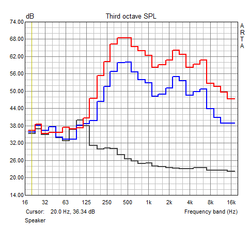
We did not expect a lot from the sound considering the thin construction, but we are slightly positively surprised. Bass is still completely lacking, and the sound is focused on medium tones, but the result is still pretty balanced and natural. Bass-heavy music with a lot of instruments often created the impression that certain frequency ranges are overemphasized and others underemphasized. We did not notice distortions or other deal breakers.
Energy Management
Power Consumption
The first issue with the Lenovo 710S is the power consumption when it is turned off and in standby, where we can measure more than 0.3 Watts. The idle consumption in general is pretty average compared to other 13-inch subnotebooks (most of them with slower processors) we reviewed over the last twelve months, but the load measurements are too high. The 45-Watt PSU does not have a lot of headroom with a maximum consumption of 43.7 Watts.
| Off / Standby | |
| Idle | |
| Load |
|
Key:
min: | |
Battery Runtime
In terms of battery capacity, our review unit (46 Wh) can only be directly compared with the Acer Aspire (45 Wh), while the Asus Zenbook and the notebook with the biggest stamina, the Dell XPS, have 56-Wh batteries. The most interesting test for mobile office users is our WLAN test at an adjusted luminance (how we test). The 710S lasts almost exactly 7 hours, which is still far away from battery monsters in the office segment, but it should last a whole business day for most users. Our Acer Aspire manages half-an-hour more, but the Zenbook has to be recharged two hours sooner, despite the bigger battery.
| Lenovo IdeaPad 710S-13ISK Iris Graphics 540, 6560U, Samsung PM951 NVMe MZVLV256 | Acer Aspire S 13 S5-371-71QZ HD Graphics 520, 6500U, LiteOn CV1-8B512 | Dell XPS 13 9350 WQXGA Iris Graphics 540, 6560U, Samsung PM951 NVMe 512 GB | Asus Zenbook UX305UA-FC040T HD Graphics 520, 6500U, SK Hynix Canvas SC300 512GB M.2 (HFS512G39MND) | |
|---|---|---|---|---|
| Battery runtime | 18% | -4% | 39% | |
| Reader / Idle (h) | 13.5 | 17.1 27% | 10.1 -25% | 23.8 76% |
| H.264 (h) | 8.1 | 9.1 12% | ||
| WiFi v1.3 (h) | 7 | 7.9 13% | 5.2 -26% | 9.4 34% |
| Load (h) | 1.5 | 1.7 13% | 2.1 40% | 2 33% |
Pros
Cons
Verdict
The compact featherweight Lenovo IdeaPad 710S-13ISK left a great impression during our review and did not really reveal any serious drawbacks. A big part of this impression comes down to the convenient aluminum-magnesium case, because we think it looks really good and the build quality convinces as well.
Another highlight is the generally very good display. The keyboard also convinces, but not the slightly sticky surface of the otherwise good touchpad. If you want to attach many peripherals simultaneously, you will have to look for another device due to the limited number of ports. A maintenance hatch is not available, but the bottom panel appears to be easily removable.
We did notice some technical weaknesses like the extreme throttling during the stress test and the slightly humming fan, but this is not important here, because maximum load will be a very rare scenario for the device in practice. Both the Dell XPS 13 9350 and the Asus Zenbook UX305FA-FC040T managed better overall scores. Therefore, we can recommend the test model and also the smaller version with the i5-6200U and 4 GB RAM in particular, because where can you get a better device in the price range between 850-900 Euros (~$962-~$1019)?
Lenovo IdeaPad 710S-13ISK
- 06/02/2016 v5.1 (old)
Sven Kloevekorn




